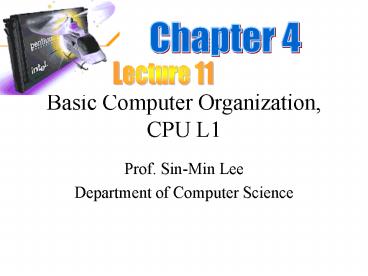Basic Computer Organization, CPU L1 - PowerPoint PPT Presentation
1 / 40
Title:
Basic Computer Organization, CPU L1
Description:
Basic Computer Organization, CPU L1. Prof. Sin-Min Lee. Department of Computer Science ... is broken into two parts: the left-most digit is an instruction code, ... – PowerPoint PPT presentation
Number of Views:63
Avg rating:3.0/5.0
Title: Basic Computer Organization, CPU L1
1
Basic Computer Organization, CPU L1
Chapter 4
Lecture 11
- Prof. Sin-Min Lee
- Department of Computer Science
2
(No Transcript)
3
(No Transcript)
4
(No Transcript)
5
(No Transcript)
6
(No Transcript)
7
(No Transcript)
8
(No Transcript)
9
- currently the fastest, most powerful CPU are
Intel Pentium III processor
10
(No Transcript)
11
(No Transcript)
12
(No Transcript)
13
(No Transcript)
14
(No Transcript)
15
(No Transcript)
16
(No Transcript)
17
(No Transcript)
18
(No Transcript)
19
(No Transcript)
20
(No Transcript)
21
(No Transcript)
22
(No Transcript)
23
(No Transcript)
24
(No Transcript)
25
(No Transcript)
26
(No Transcript)
27
(No Transcript)
28
(No Transcript)
29
(No Transcript)
30
(No Transcript)
31
(No Transcript)
32
(No Transcript)
33
(No Transcript)
34
(No Transcript)
35
(No Transcript)
36
- As the processor is waiting for the memory to
respond with the instruction, it increments the
PC. This means the fetch phase of the next cycle
will fetch the instruction in the next sequential
location in memory (unless the PC is modified by
a later phase of the cycle).
- In the first phase of the cycle, the processor
fetches an instruction from memory. The address
of the instruction to fetch is stored in an
internal register named the program counter, or
PC.
37
1. ACCUMULATOR(ACC). The accumulator size matches
that of the memory word because data is
transferred from memory to the accumulator
and from the accumulator to memory . The CPU
has the capability to add and subtract values
from the value stored in the accumulator.
38
2.PROGRAM COUNTER(PC) This register holds the
memory address of the next instruction to be
executed by the processor. 3.INSTRUCTION
REGISTER (IR) The instruction register holds
the instruction currently being executed by
the processor. The IR is broken into two
parts the left-most digit is an instruction
code, or OP CODE, while the right 2 digits
are (usually) interpreted as a memory
address. 4.CONDITION CODE REGISTER (CC) This
register holds one digit (actually either
a 0 or a 1). This register is used to store a
value based on the comparison of two numeric
values the CC has value 0 (zero) if the
compared values are NOT equal and value 1
if the values are equal.
39
Decode phase
- In the decode phase the processor stores the
information returned by the memory in another
internal register, known as the instruction
register, or IR. The IR now holds a single
machine instruction, encoded as a binary number.
The processor decodes the value in the IR in
order to figure out which operations to perform
in the next stage.
40
- In the execution stage the processor actually
carries out the instruction. This step often
requires further memory operations for example,
the instruction may direct the processor to fetch
two operands from memory, add them, and store the
result in a third location (the addresses of the
operands and the result are also encoded as part
of the instruction).

